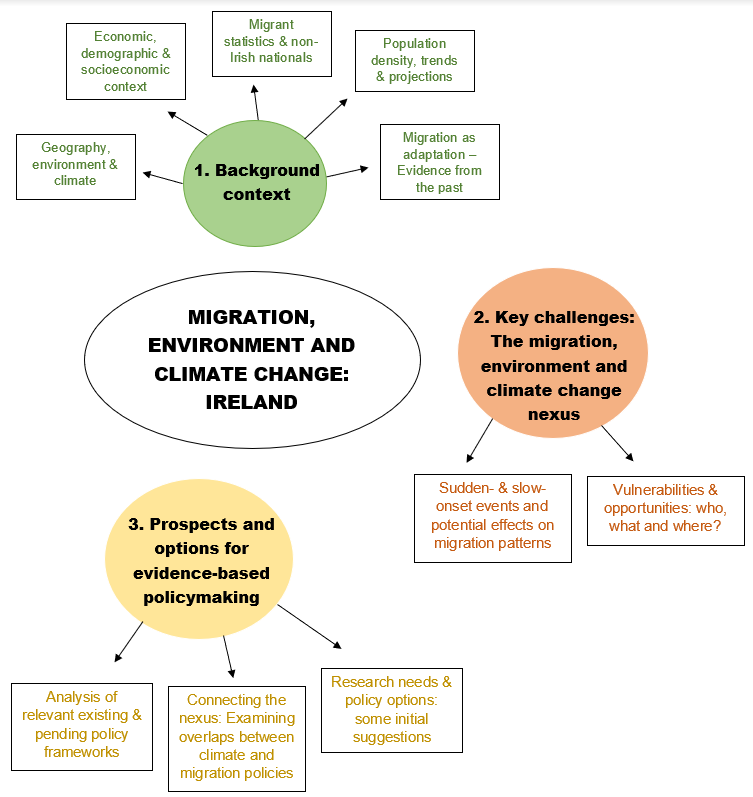For my MsCCAFS thesis, I am conducting research on the nexus between migration, the environment and climate change (MECC) in Ireland. This research is being conducted on behalf of the International Organization for Migration (IOM), the United Nations Migration Agency, as part of their MECC country profile series. This will be the first European country profile conducted, and the 16th country profile on IOM’s Environmental Migration Portal.
In preparing for the outline of the report, I examined the structure of previous reports so that I could get a better sense of the overall methodology of exploring such a dense and complicated topic. The figure below gives an outline of the structure of the report’s main three chapters: (1) Background context, (2) Key challenges: The migration, environment and climate change nexus and (3) Prospects and options for evidence-based policymaking.

To begin, the background context and rationale are established as the foundation for the rest of the report. This section provides a succinct overview of the status of Ireland in terms of its geographic and environmental composition, socioeconomic context and population dynamics. To initiate the transition from this overview, the report will outline a brief historical context of how migration was used as an adaptation strategy to unfavorable environmental and climate regimes in Ireland’s past. This will give the reader an insight into how the phenomena of the MECC nexus is not a new adaptation strategy, and that populations have been using movement to cope and build resilience long before the advent of anthropogenic climate change.
To follow this set-up, the next section provides a concise assessment of the slow and sudden onset events that are most likely to influence migration patterns within the Republic of Ireland. The report will briefly outline the different and shared impacts that slow- and sudden- onset events have on migration in general, leading to insights on how they might do so in an Irish context. Following this, a condensed overview of Ireland’s major hazards is provided, outlining how these have impacted and will continue to impact Irish society, infrastructure and economy.
Ensuing the assessment of adverse impacts, the vulnerability assessment entails the potential consequences that these hazards and degradations will have on different sectors, livelihoods, socioeconomic groups, demographics and geographic locations in Ireland. This section will aim to robustly analyse the main causes of vulnerability for each of these indicators, in order to bring attention to how migration may serve as an adaptation strategy for resilience, if approached proactively.
Lastly, the report will commence by analysing existing and pending policy frameworks that are relevant to the nexus. The MECC nexus is a broad, cross-cutting issue that will require an interdisciplinary approach, with solutions that will need to be iteratively examined as the risks and vulnerabilities change in relation to the climate crisis.
The report focuses on internal migration within Ireland while also emphasizing international migration scenarios through discussions surrounding the potential for Ireland to be a destination for populations fleeing vulnerable or uninhabitable regions that have become victims to environmental hazards and climatic degradations. Both international and internal migration futures will require resilient and robust migration plans and overall adaptation and mitigation strategies that aim to support incoming vulnerable populations as well as vulnerable populations already existing in Ireland. Synergies will be of utmost importance to these plans in order to avoid exacerbating existing vulnerabilities with inadequate or siloed responses.
Migration in response to the environment and climate change is not a simple connection to make, as there are a plethora of reasons that people choose to move within their countries borders and internationally. However, with the looming threats that climate models are projecting for our future, the case for migration in response to both sudden and slow onset events of environmental and climate degradation, are no longer just a theory – people are on the move now.